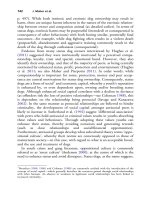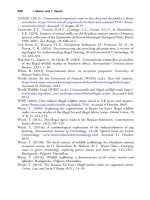The palgrave international handbook of a 287
Bạn đang xem bản rút gọn của tài liệu. Xem và tải ngay bản đầy đủ của tài liệu tại đây (38.47 KB, 1 trang )
284
K. Young
chuckwagon racing as a case study, and couching the high-risk use of horses in
the figurational language of Elias, Dunning and others, it considers shifting
views toward the ‘civility’ of the self-proclaimed ‘Greatest Outdoor Show on
Earth’. As just one site in the broader debate regarding animal rights and social
justice, the Calgary Stampede represents a fascinating setting for the assessment
of a changing social climate regarding the use of animals in all aspects of life,
from factory farming to pharmaceutical testing to sport, games and play for
popular entertainment. The use of horses (and animals more broadly) at the
Calgary Stampede has become extremely contentious and there now exists a
clear struggle between supporters or traditionalists and proponents of change.
At the center of this debate is the thorny question of how humans should treat
what Brandt called our ‘equine companions’ (2009, p. 315), and whether the
‘techniques of neutralization’ that have been used to rationalize risk, pain and
death in this century-old tradition are as compelling as they once were.
With specific respect to equine welfare in chuckwagon racing at the
Calgary Stampede, and in conclusion, this chapter makes four essential
arguments: (i) chuckwagon racing provides clear evidence of changing social
perceptions toward the use/abuse of animals in entertainment/sport; (ii)
there are obvious and acknowledged examples of harm/abuse toward the
animals involved, although it is difficult to provide an accurate account of
this due to limited data/research/transparency; (iii) the figurational approach
(and especially its core concepts of civilization/de-civilization and sportization) are helpful for understanding these shifts in social perceptions and how
they are linked concretely to changing practices; and (iv) although it is
questionable as to whether current social responses are enough (in terms of
preventing harm to animals), the appearance of more caring approaches to
animal welfare may have the paradoxical effect of softening concern even as
potential harm to animals remains very real, and injury continues.
References
Animal Aid (2015). 1371 deaths in 3309 days. .
Accessed 2 April 2016.
Atkinson, M., & Young, K. (2005). Reservoir dogs: greyhound racing, mimesis
and sports-related violence. International Review for the Sociology of Sport, 40(3),
335–356.
Ban Chuckwagon Racing (2013). Comments. />wagon/calgary-stampede. Accessed 2 April 2016.
Bancroft, N. (1978). Of mouse and man. Psychological Perspectives, 9(2), 115–124.









